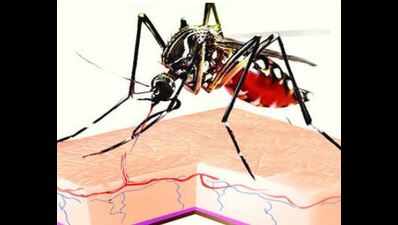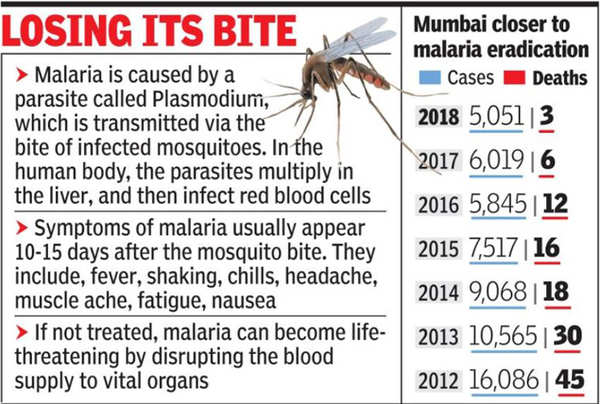- News
- City News
- mumbai News
- Mumbai malaria deaths halve, cases drop 16%
Trending
This story is from January 12, 2019
Mumbai malaria deaths halve, cases drop 16%

Representative image.
MUMBAI: The city is inching closer to its goal of eliminating malaria, recording a 50% fall in deaths and falciparum cases in 2018. Confirmed malaria cases too dropped by 16% compared to 2017.

BMC numbers show there were three deaths in 2018, down from six in 2017. More importantly, cases of falciparum malaria, considered the more serious form of the disease as it can be potentially life-threatening, declined to 92 in 2018 from 169.Around 5,051 cases of malaria were confirmed through active and passive surveillance, down from 6,019 in 2017.
Most of Mumbai’s 24 wards have achieved an API (annual parasite index) of less than 1 case per 1,000 people. The city’s API stands at 0.3 per 1,000 inhabitants, which means Mumbai is among districts in the elimination phase and is aiming at cutting local transmission.
The decline in Mumbai’s malaria cases and deaths has improved the situation across the state too. Till October last year, Maharashtra had recorded 10 deaths and close to 10,000 cases. Nationally, till October, less than 40 deaths were reported in 2018.
Applauding Mumbai’s grip over the disease, an official from the National Vector Borne Disease Control Programme said the city must now look at enhancing citizen participation so that people are prompt in seeking treatment. “Elimination is always a dynamic process and will only need further strengthening of surveillance, vector control,” the official said, adding that 66% of districts across India have achieved API of less than one per 1,000 population.
Dr Revankar said people should avail of the BMC’s free testing facility and complete treatment to get rid of the parasite. He added that chloroquine continues to be the most effective drug and there have been no cases of resistance in the last three years.

BMC numbers show there were three deaths in 2018, down from six in 2017. More importantly, cases of falciparum malaria, considered the more serious form of the disease as it can be potentially life-threatening, declined to 92 in 2018 from 169.Around 5,051 cases of malaria were confirmed through active and passive surveillance, down from 6,019 in 2017.
Most of Mumbai’s 24 wards have achieved an API (annual parasite index) of less than 1 case per 1,000 people. The city’s API stands at 0.3 per 1,000 inhabitants, which means Mumbai is among districts in the elimination phase and is aiming at cutting local transmission.
Among wards with high number of positive cases are G-South (Worli), E (Byculla) and F-South (Parel). “These are areas with heavy construction activity. However, last year, we managed to bring down cases in G-South considerably. E ward, though, still has a lot of cases,” said Dr Santosh Revankar, BMC’s joint executive health officer. He added that malaria cases were mainly being reported from construction sites. Migration and the fact that a big chunk of the labour workforce comes from malaria-endemic states like West Bengal, Bihar and Odisha are adding to the challenge. “We have already planned two drives to target these pockets more intensively and treat cases,” Dr Revankar said.
The decline in Mumbai’s malaria cases and deaths has improved the situation across the state too. Till October last year, Maharashtra had recorded 10 deaths and close to 10,000 cases. Nationally, till October, less than 40 deaths were reported in 2018.
Applauding Mumbai’s grip over the disease, an official from the National Vector Borne Disease Control Programme said the city must now look at enhancing citizen participation so that people are prompt in seeking treatment. “Elimination is always a dynamic process and will only need further strengthening of surveillance, vector control,” the official said, adding that 66% of districts across India have achieved API of less than one per 1,000 population.
Dr Revankar said people should avail of the BMC’s free testing facility and complete treatment to get rid of the parasite. He added that chloroquine continues to be the most effective drug and there have been no cases of resistance in the last three years.
End of Article
FOLLOW US ON SOCIAL MEDIA










